
The Tiszai Railway Station, operated by Hungarian State Railways, is the larger of two railway stations of the city of Miskolc, Hungary. Despite its name, the station is not close to the river Tisza; it was named after the company that built it.

The Tiszai Railway Station, operated by Hungarian State Railways, is the larger of two railway stations of the city of Miskolc, Hungary. Despite its name, the station is not close to the river Tisza; it was named after the company that built it.
Miskolc's need for connection with other cities by railway lines arose in the 1830s. Plans were made to expand the Szolnok–Debrecen railway line towards Nyíregyháza and Miskolc, but due to the political situations of the time – there was a revolution against Habsburg rule in 1848–49 – construction was delayed until 1857.
Disagreements between the railway constructing company and the local government of the city hindered work. The local government wanted the station to be built at the end of Széchenyi Street, the main street of Miskolc, approximately where the Szinvapark shopping mall stands today, and said the area that the constructing company appointed (and where the station was eventually built) was too far from the city – at that time it was indeed about 2,5 kilometres away and the cost of transporting goods from the city to the station was too high for local merchants. Because of the disagreement the local government didn't support the building of the railway lines, and on May 24, 1859 the newly built station was opened without any opening ceremony. The station was simply called "Miskolc Railway Station" then; it got its current name in 1959.
In 1860 Miskolc was connected by railway to Košice (then called Kassa, it was the other leading city of Northern Hungary and in many ways a rival of Miskolc), in 1870 the Miskolc-Pest line was ready, and in 1871 the Gömör line was built.
On June 2, 1944 the US Air Force bombed the station as a part of Operation Frantic Joe. Many bombs fell on the city centre instead, claiming 206 lives (420 were wounded).
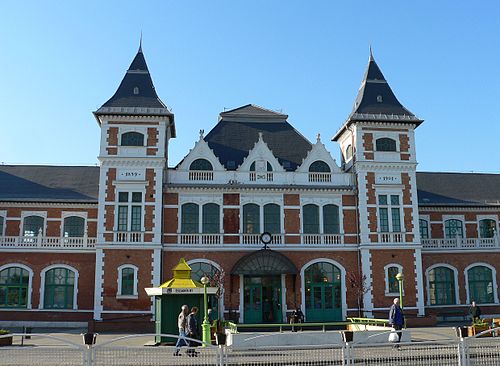
The station building that stands today was designed by Ferenc Pfaff and was built in 1901 in eclectic style. It is a listed historic building and was restored recently, in 1999. It was modernized in 2003.
During the construction of the building important archaeological findings were made, indicating a Celtic presence in the area.
The square where the station stands is one of the most important traffic hubs of Miskolc. Both of the Miskolc tram lines and several bus lines (1, 1A, 101, 17, 21, 23, 31) of MVK ZRt. have their terminus here. The square is named in honor of Kálmán Kandó (1869–1931), a Hungarian engineer who developed components for electric locomotives.
Transport in Hungary relies on several main modes, including transport by road, rail, air and water.

Miskolc is a city in northeastern Hungary, known for its heavy industry. With a population of 161,265 Miskolc is the fourth largest city in Hungary. It is also the county capital of Borsod-Abaúj-Zemplén and the regional centre of Northern Hungary.
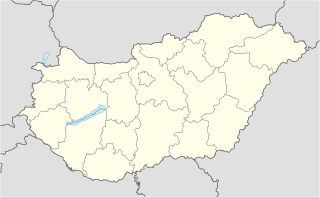
Felsőzsolca is a small town in Borsod-Abaúj-Zemplén county, Northern Hungary, in the Miskolc agglomeration. It is the city with the tenth highest population in Borsod-Abaúj-Zemplén county and the second biggest in the Miskolc agglomeration.

Tiszaújváros is an industrial town in Borsod-Abaúj-Zemplén county, Northern Hungary, 35 km (22 mi) south-east of Miskolc, near the river Tisza.
Miskolctapolca or Miskolc-Tapolca is a suburb of Miskolc, and is one of the most popular tourist towns of Hungary. Not to be confused with Tapolca town in Veszprém County.
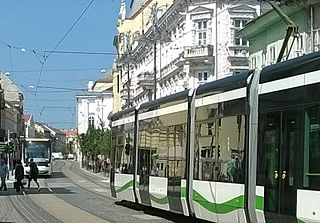
MVK Zrt. is the name of the transport company of the city of Miskolc, Hungary. Unlike the transport companies of many other cities, MVK Zrt. is independent from the company responsible for municipal transport in the county and is responsible only for the mass transportation in Miskolc and the nearby town Felsőzsolca. The buses are usually dark blue; the trams on Line 1 are yellow or red, on Line 2 are dark red. Miskolc has lots of new investments in its public transportation. By the year 2016 90% of the company's vehicles are going to be low floor.
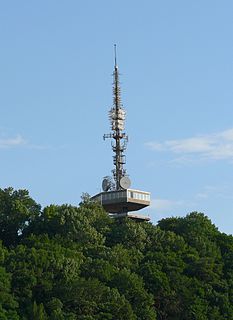
The Avas is a hill of volcanic origin in Miskolc, Hungary. Its top is the highest point of Miskolc proper. On the top stands a TV tower with observation deck which is a former symbol of the city and provides a nice panorama.

BHÉV is a system of four commuter rail lines and rapid transit lines in and around Budapest, Hungary. The BHÉV operates on standard gauge, and is electrified at 1000 V DC.

Hungarian State Railways is the Hungarian national railway company, with divisions "MÁV START Zrt.", "MÁV-Gépészet Zrt." (maintenance) and "MÁV-Trakció Zrt.". The "MÁV Cargo Zrt" was sold to Austrian Federal Railways (ÖBB) in 2007. The head office is in Budapest.
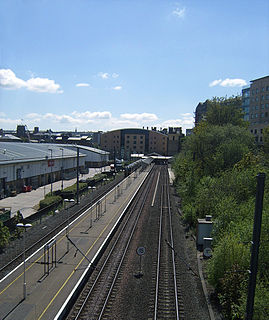
Bradford Forster Square railway station serves Bradford, West Yorkshire, England. The majority of services to/from the railway station use Class 333 electrified trains operated by Northern Trains, on the Airedale Line to Skipton, the Wharfedale Line to Ilkley and the Leeds-Bradford Line to Leeds.
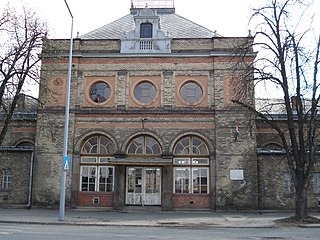
Miskolc–Gömöri railway station, operated by Hungarian State Railways, is the smaller of two railway stations of the city of Miskolc, Hungary.
Miskolc City Centre is basically the historical part of the city of Miskolc, Hungary. Most of the other parts of the city were either independent towns and villages previously, or they were built later.

Budapest Keleti (eastern) railway station is the main international and inter-city railway terminal in Budapest, Hungary.

The Palace of Music (Zenepalota) is a building in Bartók square, Miskolc, Hungary. It is in the Béla Bartók Secondary School and the Béla Bartók Music Institute Designed by Gyula Waelder in Neo-baroque style, it was constructed between 1926 and 1927. USA loans -- just like that of the Hotel Palace in Lillafüred and the Market Hall on Búza tér -- financed the project. The Palace plays an important role in the cultural life of the city. It has a large concert hall where concerts are regularly held.

Wien Südbahnhof was Vienna's largest railway terminus. It closed in December 2009 and was demolished in 2010 to be replaced with a new station, Wien Hauptbahnhof. It was located in Favoriten, in the south-east of the city. The East-bound rail services of Südbahnhof remain in operation throughout the reconstruction via provisional train station "Südbahnhof (Ostbahn)".

Deák Ferenc tér is a transfer station on the M1, M2, and M3 lines of the Budapest Metro. It is located under the eponymous city square in central Budapest, the capital city of Hungary. Owing to its direct transfer connection between three out of the four metro lines Budapest has and its downtown location, it is one of the busiest stations in the system.
Ferenc Pfaff was a Hungarian architect and academic.

The tram network of Budapest is part of the mass transit system of Budapest, the capital city of Hungary. The tram lines serve as the second most important backbone of the transit system, carrying almost 100 million more passengers annually than the Budapest Metro.
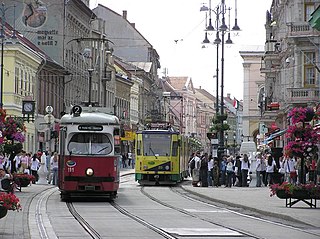
Trams in Miskolc is an important part of the public transport network serving Miskolc, Hungary. In operation since 1897, the network presently has one full tramline and two tramlines that run only on weekends.
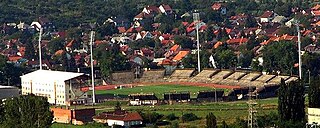
Diósgyőri Stadion was a multi-purpose stadium in Miskolc, Hungary. It was the playing field of the local football association and was the home of the Diósgyőri VTK. It had a capacity of approximately 17,000.